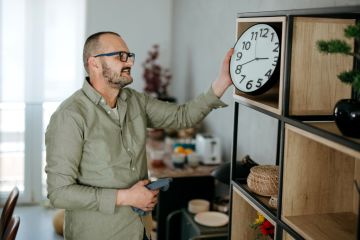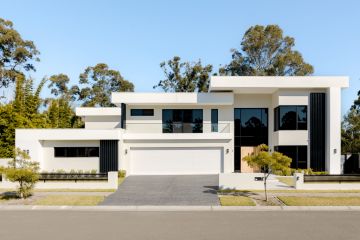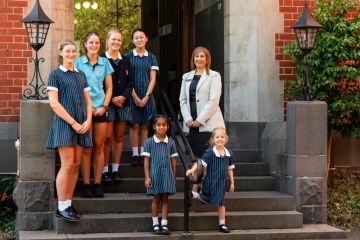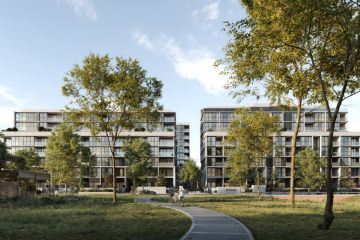International inspiration: The programs allowing Aussie artists to travel the world

Victorian artist Emilie Wright lived for a month this year on a decommissioned tug boat moored permanently in the frozen bay of Aasiaat, Greenland.
Wright had only a tiny desk space for a studio, with temperatures hovering around 40 degrees below, three boatmates and no running water. But she had the unusual experience of isolation and the vast, icy wilderness outside the boat to inspire her.
“I was very productive with the work during this time, reading and researching and hiking the terrain,” says Wright.
“The experience was incredible, challenging and fun in equal parts. Reflecting upon it now is pretty wild.”
Now back home, Wright will draw from her time on the boat to develop a series of sculptures, video work and other projects. She is one of the many artists around the world who have taken advantage of artist-in-residence programs, or artist residencies, which allow them the time and space to create.
Residencies take a myriad of forms. They can be short or long, fully funded or not, and they have different goals and objectives for the artists participating and the organisations that offer them.
The Glenfiddich Artists in Residence Program, for example, includes a prize of $20,000 and a three-month stint at the Glenfiddich Distillery in Scotland. Brisbane Airport has an artist-in-residence, who doesn’t live at the airport, but will spend 12 months creating art inspired by it. Elsewhere, you can visit Antarctica, stay at a Tuscan villa or sail the high seas aboard a commercial cargo ship.
International residencies, in particular, give artists the opportunity to interact with new worlds – and to explore landscapes, cultures and communities outside of their own. They can use this travel to inform their art.
- Related: How Ashlee is flipping Hawaiian apartments
- Related: Madeleine’s life in the middle of the ocean
- Related: What it’s really like to live in New York
“International residencies are a fantastic way to invigorate your art practice through relocation into another culture and environment,” says David Brophy, a mixed-media artist from Fremantle.
Brophy, an avid surfer and free diver, is currently at a residency at the Taipei Artist Village* in Taiwan, where he has already created work for a group show drawn from his interactions with local free diving communities. In one instance, he travelled to the volcanic island of Ponso no Tao, or Orchid Island, home to the indigenous Tao people.
Brophy, whose previous residencies have seen him travel to Bali and Cadiz, Spain, says each experience has led his art in new directions. Most importantly, he says, residencies allow artists to make art without the usual obligations.
“This is a very rare opportunity for artists, the majority of whom have to work another job to support their art practice,” he says.
Many residencies are funded through grants and scholarships, however these tend to be the most competitive. Others offer small stipends for food and travel. Some artists will pay out of pocket, with residency fees going to accommodation, studio space, exhibitions and other events.
Melbourne-based artist Brian Cheung pays for most of his residencies himself. He has spent a large chunk of the last few years working in remote areas of Iceland, Norway and Tasmania.
“In between overseas stints I work various jobs alongside the art to pull together enough to get me through the months when I’m in hiding instead of holding down a steady income,” he says. “I also love to travel, and artist residencies are a great way to kill two birds.”
In October and November of this year, Cheung lived and worked in two Scottish lighthouses, Bressay Lighthouse and Sumburgh Head Lighthouse, both organised through the Shetland Amenity Trust in Shetland, an archipelago 160 kilometres north of Scotland.
“Being so exposed, the lighthouse is constantly getting battered by wind and rain, which makes for a great soundtrack when I’m working,” says Cheung, who uses mostly ink and watercolour for his depictions of nature.
“It’s not always easy, but I feel pretty lucky that I get to do this and somehow call it a job,” he says. “Going on residencies has really helped me gain confidence in my work and shaped my perspective.”
Some residencies are organised by institutions or local groups in the hope that artists will interact with and promote local communities and cultures.
“Several of my past residencies have been set up in small towns and villages that, for one reason or another, are in decline,” says Cheung. “I think artists have a unique voice to offer new ideas, as well as to connect with and invigorate local communities, while at the same time furthering their own practice.”
Other artists are grateful for the chance to work without the distractions of everyday life. Artist Lauren Guymer went even further when visiting Finland in 2016 for a residency at the Arteles Creative Centre. This particular program called for artists to experience complete silence – no talking, just meditation, reflection and work.
“I fully embraced the quietness and time to concentrate and clear my mind from the daily busyness back home with mobiles, emails, alarm clocks,” she says. “The only other people I saw, besides the artists and patrons at the supermarket, were a couple of neighbours and some kids, usually going for a walk or skating on the frozen river.
“You get heaps of time and space to achieve things you don’t normally get to do. If you have a crazy idea then you can explore it without anyone telling you not to.”
*This Asialink Arts Residency Project is a collaboration between Asialink, Fremantle Arts Centre, and Department of AiR, Taipei Cultural Foundation and is supported by the Australia-China Council.
We recommend
States
Capital Cities
Capital Cities - Rentals
Popular Areas
Allhomes
More







